It’s amazing they haven’t outlawed the Wrangler. 
“They” being the dumbing-everything-down busybodies in DC who operate on the principle that most people are too stupid to deal with any situation on their own and therefore must be protected (for their own good, naturally) against the possible repercussions of any low-IQ move by anyone.
Of course, most people aren’t in need of such condescending coddling. But the low-IQ moves of a few people – such as driving an off-road-intended 4×4 at 90 MPH on road on a 90 degree day on bald and under-inflated tires (with the predictable consequences) give them the excuse to micromanage all of us – and ruin everyone’s fun.
The Wrangler has somehow escaped the noose.
It is built like they used to make ’em: Body-on-frame, solid axles front and rear. There are no compromises imposed on its off-road capabilities in order to idiot-proof the beast for on-road use by people who expect a 4×4 to corner like a Corvette.
It is a vehicle for people who understand what an off-road vehicle is for.
And also, what it is not for.
If you understand the difference, you’ll appreciate the Wrangler. And if you don’t understand, buy something else.
Please.
The Wrangler is an icon – one of the earliest mass-market 4x4s, its roots extending all the way back to the WWII-era Willys Jeep. Though updated through the years, the 2012 model is obvious kin to Jeeps of 40, 50 even 60 years ago. It is also a time machine – its hard-core mechanical essence having survived the years in addition to its familiar exterior cosmetics. The old Ford Bronco is long gone; so also the International Scout. The Land Rover 110 and Defender 90 are memories.
But the Wrangler soldiers on.
It’s available in two and four door versions, with hard or soft-tops. All versions are 4×4. Real 4×4, with a two-speed transfer case and Low range gearing.
Base price for a two-door Sport is $22,045. An Unlimited Rubicon starts at $33,570.
There really isn’t any direct competition, price-wise or otherwise. The Toyota FJ Cruiser is vaguely similar in theme – but it starts at $26,116 and it’s much more street-minded than the Wrangler. The closest thing is probably a Land Rover Defender 90 – but of course, they don’t sell those here anymore.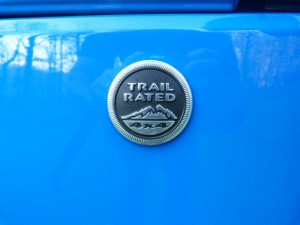
WHAT’S NEW FOR 2012
A heart transplant. The Wrangler now comes standard – all trims – with Chrysler’s stout 3.6 liter “Pentastar” V-6 and 285 hp. A five-speed automatic (replacing the old four-speed unit) is also available with the new engine.
A six-speed manual remains standard equipment.
WHAT’S GOOD
Old school. No BS. A 4×4, not an “SUV.”
Lawnmower-tight low-speed turning radius in the short-wheelbase two-door.
Massive power infusion from new 3.6 liter V-6 (83 hp more than previous V-6).
WHAT’S NOT SO GOOD
Arguably too much power – and not enough efficiency. A diesel version would be welcome.
Gets pricey quickly. Jeeps are no longer cheap!
UNDER THE HOOD
The ’12 Wrangler – all trims – comes standard with a 285 hp 3.6 liter V-6, the same “Pentastar” engine used in other Chrysler-Jeep models such as the Grand Cherokee. 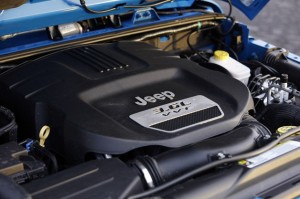
It’s 83 hp stronger than the previous V-6 – a roughly 30 percent improvement in power output. And the added power doesn’t come at the cost of MPGs. In fact, the new 3.6 engine returns better mileage (17 city, 21 highway for the two-door) than last year’s model with 83 hp less (15 city, 19 highway).
Acceleration is also much improved. With the standard six-speed manual, the Wrangler two-door can get to 60 in about 7 seconds flat – almost three full seconds quicker than last year’s Wrangler.
A new five-speed automatic is optional – replacing the previous four-speed automatic.
All Wranglers come with 4WD (shift-on-the-fly manual engagement) but Rubicon versions get a beefier transfer case with different (lower) gearing for severe off-roading. In addition, this version of the Wrangler is fitted with very aggressive 32-inch M/S-rated knobbies on 17 inch wheels, heavy-duty Dana axles, locking front and rear differentials and a front sway bar that disconnects to allow greater suspension articulation as when rock crawling.
All models feature a snorkel-style air box, with the intake mounted as high up as possible and tucked underneath a deflector to keep water out.
Most new cars are metronomic – they drive almost effortlessly. That is, they demand very little of the person behind the wheel in terms of skill or even attentiveness. So long as it’s pointed in the general direction, it will usually end up there – and if the driver makes a mistake in a typical late model car, the car is usually so inherently stable that unless there’s outright deliberate recklessness involved, it’s pretty hard to get into serious trouble.
The Wrangler is not like this. It isn’t metronomic. It does require you pay attention. And have respect for what it is.
And for what it isn’t.
A short wheelbase (95.4 inches for the two-door, which is about 7 inches shorter than a current-year economy compact sedan’s – and almost 11 inches less than the Toyota FJ Cruiser’s wheelbase of 105.9 inches) helps make the Wrangler highly maneuverable at low speeds. It has a turning radius as tight as a riding lawnmower’s. Off-road, when you’re negotiating narrow trails or making fine adjustments to your position in order to not hit something – or not tumble over the precipice of something – this is just what you want.
The Wrangler is a billy goat – nimble and tenacious.
It is also stubby and narrow – 1.5 inches more svelte in the hips than an FJ Cruiser and more than two feet shorter, nose to tail. This likewise gives the Wrangler more room to work with off-road.
So, what we have here is not unlike a human powerlifter – a focused, no-compromises machine built to do one thing extremely well. The downside, as with the human powerflifter, is that being so focused on one thing means not being as good at some other things (like, say, running a marathon for the human powerlifter).
For the Jeep, it means remembering what you’re driving when you’re driving on paved roads. It is not unstable or tip-prone in the way that an older Jeep CJ was, but it should be driven with prudence in corners and not too fast on the straights – even though the powerful V-6 has more than enough guts to overcome the two-ton curb weight and wind resistance of the near-vertical windshield/box profile with deceptive ease. The short wheelbase/high center of gravity and a suspension/steering system are optimized for fire trails and low-speed crawling and not set up to deal with high-speed cornering or sudden course corrections at 80-plus.
People who know 4x4s know this, of course. And so drive with respect for the Wrangler’s different abilities.
And – so far – the rougher nature of the Wrangler has kept away the know-nothing “SUV” types – the type who would expect an off-road 4×4 to corner like a sports car or even a regular car and then get mad (and probably sue) when they discovered (the hard way) that it didn’t.
The four-door Wrangler has a larger footprint: 116 inch wheelbase and 173.4 inches long overall vs. 152.8 for the two-door. This makes it slightly less adroit off-road – if you’re off-roading in dense woods or similar – but also makes it a bit less darty-feeling on-road.
In either version, you sit bolt upright and high off the ground. You’ll hear the wind outside – and also the bugs splatting hard against the flat glass in front of you. It’s as different and homey and appealing in its own way as a toasty if a little bit smoky wood stove in a camping cabin on a cold winter night.
Not everyone will get this, of course. But if you’re someone who does get it, you’ll love this thing.
There’s no mistaking a Wrangler for any other vehicle. The iconic shape is one of the draws. It marks you as someone who knows what he wants – and doesn’t want what most other people do.
Most people want door air bags. The Wrangler has removable doors. Available with plastic windows.
Most people want a completely fitted out, tightly insulated interior. The Wrangler has exposed metal – and a fitted roll bar Velcro-wrapped with padding.
Sure, you can order amenities such as heated seats, climate control and GPS. But this no more dilutes the essential character of the Wrangler than putting an Ultimate Fighter in a two-grand suit.
The sectional hard top is a big improvement over the old one-piece deal – which almost required a pulley-lift system to remove and once off – what do you do with the thing? The current model’s removable hard top still comes off all the way, too – but you can also remove just the panels over the driver and front-seat passenger, creating a T-top effect. Or, go with the cloth soft-top. It has its pros and cons. On the pro side, it’s easier to handle because it’s lighter and you can fold it/roll it/stuff it into a corner once off. But it’s no easy thing to take off in the first place – or put back on. The hard top, being made of rigid composite panels, is easier to get into place – but it’s heavier and more awkward to manipulate, especially if you’re just one person or not a strong young man.
I recommend you get the salesman to walk you through the removal/installation process of both top types before you decide which to buy. I mean, have him actually show you how it’s done – not just describe how it’s done.
And if you’re new to Jeeps – take an extended test drive. Again, this is not a vehicle for everyone. It might not be for you.
THE REST
The two-door model is the most personal – and least practical. The back seats are there. That’s about the most you can say about them. You literally have to crawl over and around to get back there – consider it a prelude to your off-roading adventure. And because this is a real-deal 4×4 and not an SUV (much less a “crossover,” god help us) there is no theater-style seating. The floor is close – and so will your knees be. If I bought the two-door, I’d just put the back seats in the garage. Less weight and now there’s a good-sized cargo area (61.2 cubic feet vs. a puny 17.2). And if you’re going to be using the Jeep properly – for offroading – the inside will get pretty dirty. I’d recommend upgrading the stock floor mats to something like a WeatherTech to protect your floors.” . 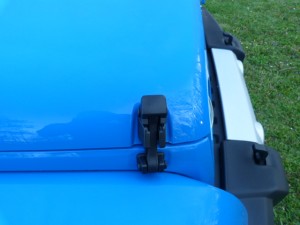
Jeep gives you a locking center console, in addition to the locking glovebox – good to have, especially if you’ve got a Wrangler with the soft top or plastic windows. This “easy access” is another attribute that sets the Wrangler apart from anything new or even remotely new that’s not another Jeep. Be aware that even the engine compartment can be opened, ’70s-style, from the outside. Just pull-off the rubber tie-downs on the top of the hood and then pop the catch.
There are also old-school push-button door pulls – and an exposed gas cap!
The one thing I’ll carp about is no diesel engine on the options list. Diesels, which produce tremendous low-RPM torque, are the ideal powerplants for off-road 4x4s. They’re also extremely durable and most important of all these days, far more fuel-efficient than a gas burner. The new 3.6 V-6 is admirable for producing 83 more hp than the old 3.8 V-6 while returning slightly better fuel economy, but the fact is that 17 city, 21 highway still sucks in a world of $4 a gallon gas. As impressive as the 283 hp Wrangler is, it’d be even more appealing with a 350 lbs.-ft turbo-diesel under its hood. A turbodiesel capable of 30 MPG on the road.
THE BOTTOM LINE
Very few vehicles make you feel so much a part of the driving experience as this one does.
It has a pulse – and it will raise yours.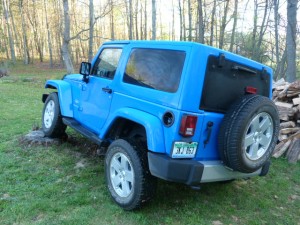
Throw it in the Woods?





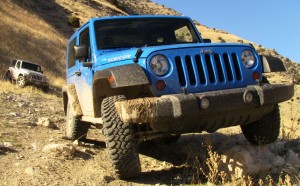









Eric. Enjoyed the article. I would love to read an article by you on the Wrangler TJ, 1997-2006. I have a 1999 Sport so I’m partial to the JKs predecessor.
They do make a factory diesel version. It is made at a plant in egypt and illegal for import to the US I am fairly certain. We can thank mommy government for protecting us from big mean powerful efficient diesel jeeps.
http://en.wikipedia.org/wiki/Jeep_J8
Also, it is worth mentioning, the front windshield is still hinged and folds down, for a real outdoors experience. It just requires some time and a good star wrench.
Roger that, Phil – thanks for the link!
I’ve been thinking a lot about trading in my 2002 4Runner Limited for the last year of the straight six 4.0L Wrangler. The major thing holding me back is the tow capacity. Plus I know I’ll get over 300k on the 4Runner and I’m only at 120k now.
What do you need the Wrangler for? If it’s just for off-roading/occasional use, you might consider going older and shopping for a CJ… these are tough SOBs, though not the ticket for regular highway use.
Just going to have the wife drive it for beating here around town, her and the kid. She only drives 50 miles or so a week. Plus in the winter it would be the deal. The 4Runner is a sick truck though.
Then I think an older Wrangler or CJ will be fine; look into used Postal Jeeps – they’re often auctioned off for next to nothing.
Dom, the postal jeeps (DJ or Dispatcher) were 2 WD with heavy suspension (designed as cargo haulers which is how they ride and handle) so if you’re looking for a snow vehicle, for mama, a DJ’s probably not a good choice. The CJ’s don’t have the body metal treatment (i.e. watch for cancer, especially at the body mounts) or the 4.0 I6 of the later Wranglers. The CJ-5 has a really short wheelbase, weak springs and axles (stock anyway). With the 304 V8 you can pull the front wheels off the ground in CJ-5(but it’s hell on the drive-train). The 258 straight six in a CJ (and the 1991 and older YJ Wrangler) doesn’t even compare performance wise to a 4.0L I6 in the later YJ and TJ series Wranglers. There was an optional Perkins 192 Diesel offered in the early 60’s CJ that would be pretty cool to have, but parts might be a problem if you could even find one. A CJ-5 or even a CJ-7 is a pretty darned Spartan vehicle for your wife unless she is the reeeeallly outdoorsy (and I mean hardcore) backwoods off-road kind of gal who doesn’t give a hoot about creature comforts (like a heater that actually works). An early CJ might be the ticket for you, but I doubt your wife would find your replacing a 4Runner with a CJ very amusing at all. 🙁
The YJ Wrangler (rectangular headlights) is more comfortable and handles better than the CJ’s IMO, but no airbags, carpet or other superfluous BS. Granted my ’93 Wrangler has AC, tilt wheel and an AT (I’d recommend the 5 spd. manual for fuel economy). The TJ Wranglers went to coil spring suspension (even better ride and handling) and returned to the traditional round headlights of the CJ (if you’re a purist, this is important). I’d strongly suggest that you take your wife to test drive one before you consider buying a Wrangler (or especially a CJ). I’ll tell you this, there is nothing like riding around with the top and doors off a Jeep in the summertime. A Jeep is something you’ll either love (like a Harley) or something you probably don’t want to own; I doubt there’s a grey area. 😉
I’m thinking about cleaning out the fleet a little bit and getting a more useful street vehicle, or a skid steer! ha
I’ve gotta lean out!
As of now I have a 2010 Yairs, 2002 4Runner, 1996 Harley Electra Glide, 1994 Saturn SCII, 1991 GMC Top Kick 18′ Box Truck, 1982 El Camino, Brimar 14′ trailer, and of course my 1985 Honda 350x three wheeler.
Just thinking though!
I really like the Wrangler. Always have. Especially like the new power. It desperately needed it. I’ve driven others and really enjoyed the ride/drive quality. But I knew what the truck was for and that it wasn’t intended to be, nor is it capable of being, a comfortable cruiser. Heck, you don’t really even need a radio in the thing because you can’t hear it unless you have the hard top.
My biggest problems with it are
1) the cost – This is one of Chrysler’s perennial money makers. They aren’t big sellers, but they’re huge profit centers. If it didn’t have the throwback styling, which I love and is an American icon. IF all the guts of it were wrapped in a small SUV package, changing nothing else, it would be a $15k base with a $20k optioned out max price. There’s nothing expensive or hard to produce in the whole thing, and it’s ancient technology, for the most part, that is pretty well sorted out. Yet they get to make a huge profit off of each sell. That’s mostly due to #2
2) the image – I AM comfortable in the back country in a 4×4. I love to hit the mud holes and find the perfect hunting/fishing spot. This truck is designed for me. Yet it is perhaps the quintessential teeny-bopper chick car, even more so than a BWM 3-series. Aside from a few places near the Rockies, the only people who drive these in most of the US are girls and women from about 16 up to about 25. Usually the spoiled rich kind. Now don’t get me wrong, I’m not generally too concerned about my masculinity, and wouldn’t have a problem driving it, but it is because of this demographic that these darn things cost so much. They’re not too much cheaper than a 3-series coupe, and much harder to drive. Add another 30% more horsepower, and you go from teen girl (and their teen boyfriends) driving a vehicle so slow that it’s difficult to get into too much trouble, into a much faster, and deadlier, projectile.
3) the reliability – Let’s face it, Chrysler is bottom-rung for reliability and more time is spent on image and looks than actual engineering. The basic mechanicals, as I mentioned above, should be fairly reliable as it’s kind of like screwing up cereal, it’s hard to do. But the electrical, interior/exterior, body, etc. will have lots of problems. Everyone I know who has had them in the recent past got visitation rights while the mechanic had custody. Since you’ll have to buy two so that you’ll always, hopefully, have at least one running, you kind of double the price of entry.
I really and truly wish someone would make a simple, reliable, cheap, and smallish 4×4 truck with solid axles front and rear, body on frame, and lots of steel. Unfortunately, the Wrangler is the last of a dying breed, and vultures are circling. Could you imagine the ka-pow of an electric Jeep’s battery pack getting submerged in a water crossing?
I’m wondering when motorcycles will be outlawed.
Spot-on analysis, SJ – especially as regards the potential for Trouble with the new, powerful engine and the (typical) “special” behind the wheel.
I, too, wish someone would make something simple and rugged as you’ve described. My old model Nissan Frontier is close. I recommend these (1998-2004) to anyone interested in a rugged, relatively simple, immensely durable little truck. The only downside to them is that excepting the ’98s, you have to buy the V-6 to get 4WD. And the V-6 is not as durable as the four – and much harder (and more expensive) to work on. The pick of the litter is the ’98 regular cab XE with the four-cylinder, manual hub 4WD, and 5-speed manual transmission.
With their fairly new from ends, and the body colored hardtops, they look absolutely great! Here in Arizona, many folks use them as daily drivers. Sort of a “lifestyle statement.” Most of them do “some” serious off roading, but it usually represents less than 5% of their time behind the wheel. As much as I love the new Wrangler, don’t think I could own one as a daily driver unless I drove at least 25% off road.
I could use one as a daily driver – because I live in a rural/mountainous area and most of my driving is on “country roads,” not freeways. But two things would (do) keep me out of the game: The cost of the vehicle itself (the Sahara I tested stickered out at nearly $38k) the cost of taxes (Virginia has an annual property tax on vehicles that’s confiscatory) and the cost to feed the thing.
I’d be more inclined to buy an old (’70s) CJ.
IMO automatics are tlrbiree for extreme off roading areas due to the problem of crawling with an automatic and converters not locking up on low rpm. What happens is when you are crawling over boulders and run up against them, the converter is not locked up so you have to give it some gas to lock it up to get over the obstacle, with a lot of resistance you have to give a fair amount of gas and when you reach the top of the rock you are going FLY over the obstacle. With a manual transmission, and manual transfer case, I just put it in low range, and let it creep. There’s a really bad area that we go into and the challenge is a steep hill of over 3/4 miles of HUGE rolling boulders, I make it everytime with ease with my 4 4. I’ve been there with many jeep clubs over the years and everytime I’ve been there NOT ONE AUTOMATIC 4 4 has ever made the hill.
“All models feature a snorkel-style air box, with the intake mounted as high up as possible and tucked underneath a deflector to keep water out.”
Fail. Last summer in CO with my bro we watched a brand new Wrangler hit an 8 inch deep by 14 feet long puddle and the Jeep dropped dead right in the middle of it! After sharing some chuckles with the driver, we pulled it out with our truck, popped the hood and water was everywhere inside the engine compartment. The engine would not turn over at all so it was most likely an electrical issue. Seemed like crap engineering for a vehicle supposed to be driven off-road. I’m not likely to buy one any day soon.
The air cleaner design is to prevent hydraulic lock – a separate issue. The air snorkel is vertical and as high up in the engine compartment as you can get without cutting a hole in the hood. I think you’d have to submerge the front end (or close to that) for water to get into the engine.
I can’t speak to the electrical problem you describe. However, given the profusion of sensors and wiring, that stuff had better be triple insulated and tight!
One more area where a diesel would be superior to a gas burner. At least a simple diesel.
Problem with the diesel engines is EPA Ministry Tier 2 Bin 5.
No diesel engine made today will meet that reg.
All diesel engines sold today have EPA waivers…Give EPA millions of dollars and they give you a waiver…It is a Mafia within a Mafia.
HC + PM + NOx limits can not be met with diesels.
Yup – which shows how much the government cares about fuel economy.
And PS: It’s not concern about “the environment,” either (as I’m sure you know). The Europeans are extremely persnickety about air quality/emissions and yet about 30-40 percent of all passenger cars in most Western European countries are diesel powered.
Not so much in the past.
If you ever go to that gloomy little primitive place (The EU Borg Collective) you will see that everything is covered in diesel soot in the crowded cities (I lived there in the 90s). Even Euro 6 (next year) diesel emissions are FAR easier to meet than Tier 2 bin 5. The Euros will not be able to run their diesels in lean burn mode because of the NOx it produces. Diesel mileage (kilometerage?) will then drop and the gasoline engines will start to look more reasonable.
My mom had a brand new Wrangler Sahara back in 1998. That thing was absolutely AWESOME! Just an extremely fun vehicle. I can’t imagine how great they must be with the extra hp and gears! How sweet would a diesel Wrangler be! Anyone wanna trade for my 2002 4Runner Limited?
Amen. I like the Wrangler a lot, too. The only thing I don’t like is the cost. The ’12 Sahara that’s sitting in the driveway right now stickers out at almost $38k. Part of the reason for this is the now-standard 283 hp V-6. It’s a great engine, don’t get me wrong. But for the type of vehicle the Wrangler is – and for what I’d use it to do – a four-cylinder would be fine. But then, they can’t put a four cylinder into the Wrangler anymore because it weighs almost 4,000 lbs. empty.
So, gibs muh an older CJ, maybe a former postal service unit.
Better: Let Jeep offer a stripper – no insulation, no AC, no air bags (etc.) and get the weight down to a more reasonable 3,200 lbs. or so. Install a four cylinder diesel and manual transmission. Out the door for about $25k.
I just looked up some specs of a WWII jeep. 60 hp. Think how cheap and how good the gas mileage would be with that. Sure would beat the 19 mpg highway. I would never drive a vehicle like that daily anymore that only topped out at 19 mpg.
Here you go:
http://green.autoblog.com/2010/09/30/diesel-powered-jeep-wrangler-with-start-stop-unveiled-for-europe/
Of course if you’re in the land of “the free” you can get an old CJ and convert it:
http://www.jdjeeps.com/
I think the reason the Ministry of Highways doesn’t get worked up over the Wrangler is because the Ministry of National Parks uses them. I see them all the time, shiny and new with their Dept of Interior license plates (which makes them exempt from paying the outrageous plate registration fees here in Colorado). Funny but they never seem to get dirty.
Out here, I see just as many Wranglers as I see Audis, and many of their owners spent as much as an Audi on upgrades. Personally, while I see the point, I just don’t see them as a daily driver.
I’m also from CO and I agree. Wranglers and really anything else with two live axles are just too unpleasant to drive daily. I definitely understand and appreciate the point of the thing. But I would want one as a toy and either keep it barely street legal or not at all. Furthermore, the things really aren’t good on the road at all. Even when there is snow, yeah you have 4×4, but you’d be better off in an Audi or Subaru.
I put 150,000 miles (on top of the 86,000 miles on it when I bought it) on my old Scrambler (CJ8) before selling it, and that’s with leaf springs all way ’round and a much “looser” fit, i.e. lot’s of wind noise through many gaps. Very drivable if you’re careful, and highway drivable if geared properly – I could easily do 75 MPH.
Of course, most of my “upgrades” made it more suitable for highway driving – better brakes, fuel injection, larger fuel tank, etc…. The longer wheel base also helped. I never lifted it or used over-sized tires.
Yup –
It comes down to what you (as an individual) want and are comfortable dealing with. Sure, the Jeep is a beast compared with a Camry or something along those lines. But if (as you’ve written) you drive it with respect (not too fast on road, etc.) it can be a liveable machine. Not for everyone, of course. But that’s part of the fun of it!
You can buy a brand new Jeep Wranglers & Unlimited with diesel engines in Austrailia. I picked one up when I was stationed there with the US Navy. But the US tax payers covered the cost for my move to Florida since it was a PCS move! Sorry guys but thanks for the move!